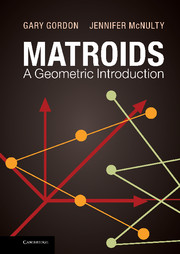5 - Finite geometry
Published online by Cambridge University Press: 05 November 2012
Summary
Matroids can be thought of in many different ways; we tried to make that point in Chapter 2. But the common thread running through all of our different approaches to the subject is the underlying connection to geometry. When we “draw a picture of amatroid,” we are thinking of the elements of the matroid as points and the dependences as lines, planes, and so on.
Geometry in the plane motivates our treatment of affine geometry. Although the word “affine” may be unfamiliar, affine geometry based on coordinates covers very familiar material; points in the plane correspond to ordered pairs (x, y), points in three-dimensions correspond to ordered triples (x, y, z), and so on. Lines in the plane are given by linear equations of the form ax + by = c for constants a, b and c, planes in 3-space are described by equations of the form ax + by + cz = d, and this also generalizes to higher dimensions.
From the geometric point of view, here's what you learned long ago about points and lines in the plane:
A: Every pair of points determines a unique line, and
B: Given a point P and a line l not containing P, there is a unique line through P parallel to l.
Our matroid interpretation for property A is direct;
• If a and b are non-parallel points in a matroid, then they determine a unique rank 2 flat of the matroid – see Figure 5.1.
- Type
- Chapter
- Information
- Matroids: A Geometric Introduction , pp. 180 - 220Publisher: Cambridge University PressPrint publication year: 2012

